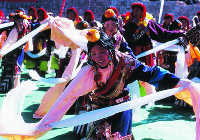|
Guozhuang Dance
( 2005-10-17 )

Guozhuang in Tibetan is homophonic with Guozhuo, which means singing and dancing in a circle. It originated from the form by which Tibetans danced around a campfire, all the time. This dance has been with the Tibetan ethnic group throughout their history.
Guozhuang consists of singing, and quick singing and dancing. The tempo is subdivided into slow, medium, and quick. At the beginning of a performance, men and women stand in two separate circles and sing in rotation while swaying and stamping their feet. They conclude their singing by shouting "Ya!" Then their steps quicken and come to a stop at an exuberant allegro. The allegro music is often a condensed version of the slow music.
There are four kinds of Guozhuang:TempleGuozhuang, Pastoral Guozhuang, Farm Guozhuang, and Forest Guozhuang.
The Temple Guozhuang event is organized for religious purposes in temples or monasteries, or for greeting and sending-off the Living Buddha. It is solemn with strong religious implications, through which believers dance in honor of the Living Buddha, grateful for their expected bliss in their afterlife.
The other three kinds are enthusiastic, unrestrained, and somewhat complacent. They are organized for festivals and big occasions.
The movements of guozhuang are agile and vigorous. The loose, wide trousers of the male dancers look like the feathered legs of eagles, and the men's movements are imitative of creatures, especially eagles, such as an eagle spreading its wings, hopping, and soaring. Women expose their right arms during dancing, with the right sleeve waggling behind. Moving around a circle, they sway their joined hands frontward and backward, keeping beats of their steps, until very late at night.
The emphasis is on the postures and expression of emotion. The verses for one song read: "Oh snow-capped mountains, make way for us. We fly with wings spread. Oh rivers, make way for us. We stride with broad steps." These old verses display Tibetans' brave and bold character.
|

